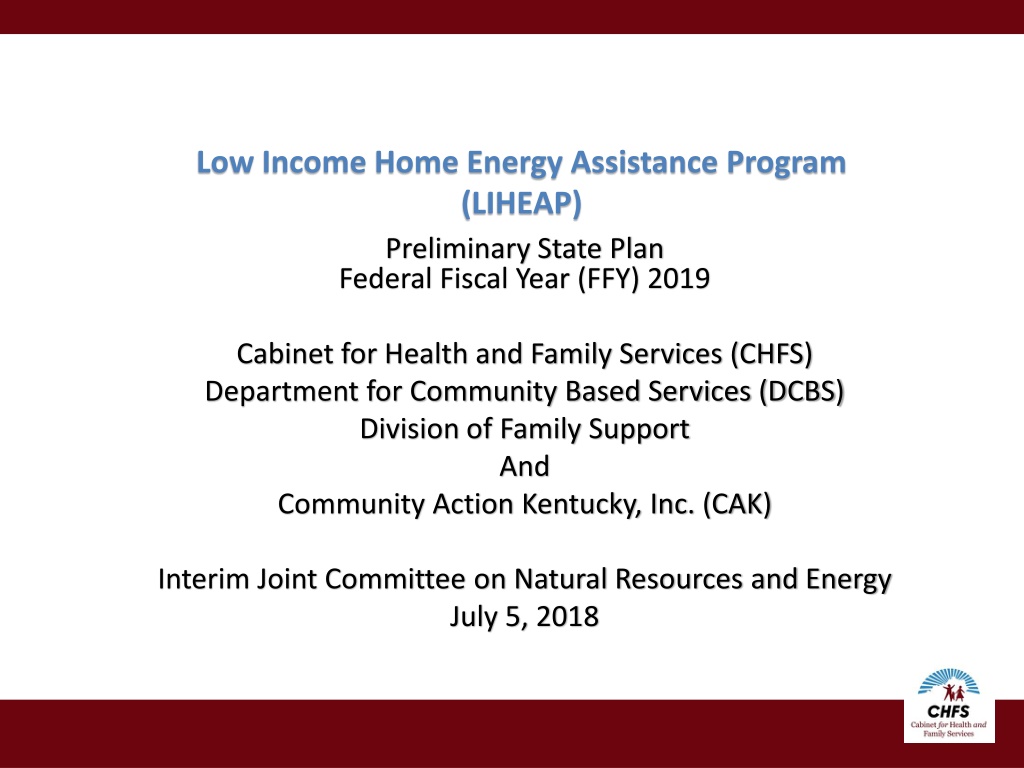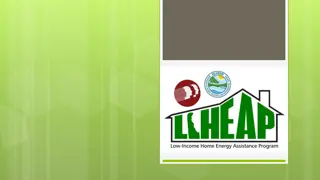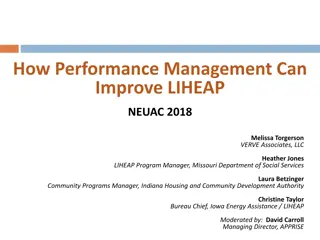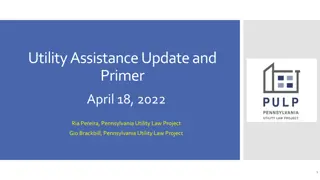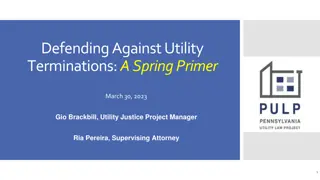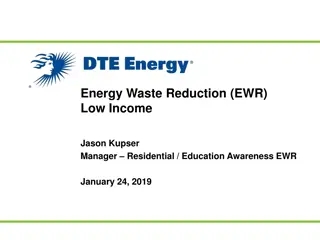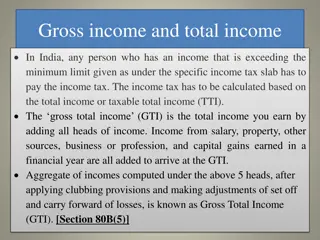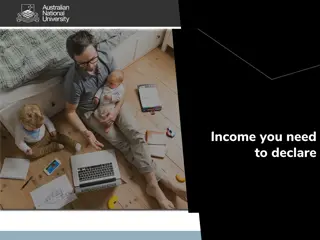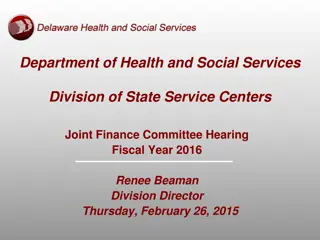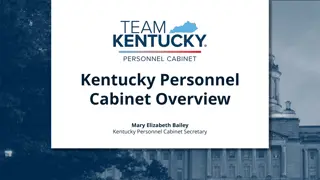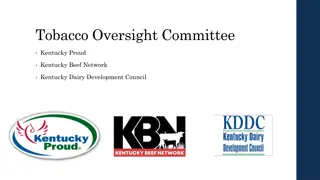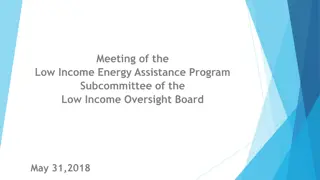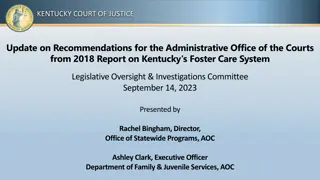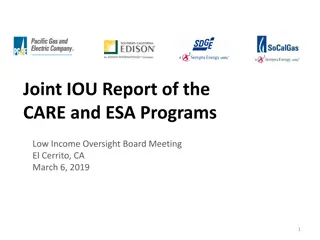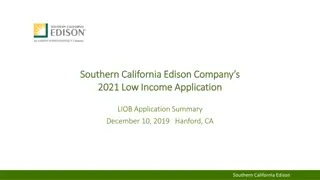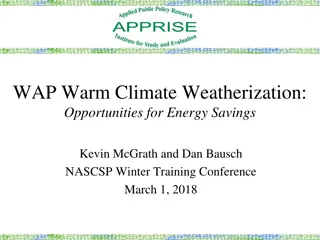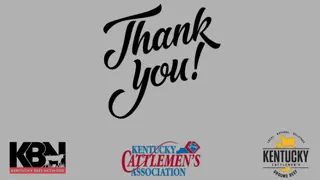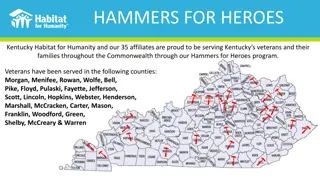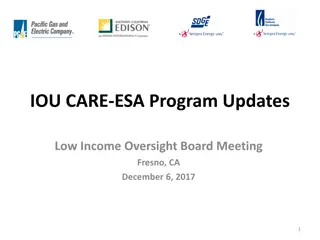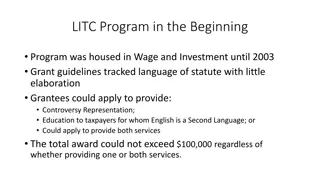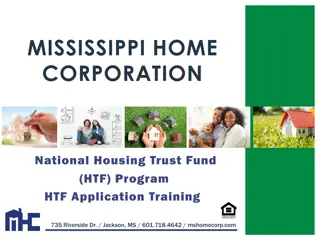Low-Income Home Energy Assistance Program (LIHEAP) Overview in Kentucky
The Low-Income Home Energy Assistance Program (LIHEAP) in Kentucky provides assistance to low-income households for their home energy needs. The program offers bill payment assistance, emergency aid, summer cooling support, and weatherization services. The Department for Community Based Services partners with Community Action Kentucky, Inc. and Kentucky Housing Corporation to deliver benefits to eligible citizens. The 2019 program year anticipates a federal award of $48M, with majority allocation for direct benefits and a portion towards administrative costs and other programs.
Download Presentation

Please find below an Image/Link to download the presentation.
The content on the website is provided AS IS for your information and personal use only. It may not be sold, licensed, or shared on other websites without obtaining consent from the author. Download presentation by click this link. If you encounter any issues during the download, it is possible that the publisher has removed the file from their server.
E N D
Presentation Transcript
Low Income Home Energy Assistance Program (LIHEAP) Preliminary State Plan Federal Fiscal Year (FFY) 2019 Cabinet for Health and Family Services (CHFS) Department for Community Based Services (DCBS) Division of Family Support And Community Action Kentucky, Inc. (CAK) Interim Joint Committee on Natural Resources and Energy July 5, 2018
DCBS Organizational Structure Elizabeth Caywood, Acting Commissioner DCBS Organizational Chart 2018 Division of Administration & Financial Management Division of Protection and Permanency Division of Service Regions Division of Family Support Division of Program Performance Division of Child Care
LIHEAP LIHEAP is a block grant established in 1982. It resulted from various efforts in the 1970s to offer low- income individuals and families a safety net with their heating and cooling costs and energy conservation measures. LIHEAP s mission is to assist low-income households with meeting their immediate home energy needs. Assistance is targeted towards those households with the lowest incomes that pay a high proportion of income for home energy.
LIHEAP In the preliminary block grant application before this subcommittee, the Department for Community Based Services (DCBS) anticipates Kentucky s award will be $48M for 2019 program year. This award is 100% federally funded with no match requirement. 90% of the award will be used for benefits to eligible Kentucky citizens. Less than .2% is retained by DCBS for the Preventive Assistance Program to assist families receiving child protective services with an energy payment. $30,000 is available to design and initiate leveraging activities. Agencies often retain a small percentage (up to 5%) of their individual allocations to promote household self-sufficiency. Up to 15% can be allocated for Kentucky Housing Corporation (KHC) for weatherization. Less than 10% of the award is used for administrative costs.
LIHEAP The Department for Community Based Services maintains a contractual arrangement with the Community Action Kentucky, Inc. (CAK) and the Kentucky Housing Corporation (KHC) to provide administrative support, training, monitoring, and technical assistance to the front-line service delivery system. CAK and KHC sub-contract with the 23 agencies of Kentucky s Community Action Network for frontline service delivery. Kentucky s Community Action Agencies make LIHEAP benefits available in all Kentucky counties.
LIHEAP LIHEAP offers the following types of benefits to Kentucky citizens: Bill payment assistance: oSubsidy component; and oCrisis component; Emergency assistance; Summer cooling (rarely instituted crisis component contingent upon available funding); and Weatherization activities to increase the energy efficiency, health, and safety of eligible low-income individual s dwellings. Assurance 16 to provide energy reduction solutions and education.
LIHEAP Kentucky provides bill payment assistance to those households whose incomes do not exceed 130% of the federal poverty level as established annually by the U.S. Department of Health and Human Services. Household income must be at or below the following, relative to household size: Household Size Gross Monthly Income 1 $ 1,316 2 $ 1,784 3 $ 2,252 4 $ 2,720 5 $ 3,188 *Add $468 for each additional family member The applicant must be responsible for the home heating costs or pay heating costs as a designated portion of rent.
LIHEAP LIHEAP Subsidy Component: Offsets home heating costs for those households with the lowest incomes and highest seasonal energy costs; Has benefit amounts structured by a percentage of the household s annual heating costs and percentage of poverty met by the household; Includes application processing starting in early November and running through mid-December; oElderly individuals and those with disabilities may apply in October; oAppointments are available.
LIHEAP LIHEAP Crisis Component: Offers assistance for an energy emergency; Includes application processing beginning in January and typically running through March; Requires that all households with incomes above 74% of the federal poverty level pay a co-payment or a percentage of the crisis component benefit.
LIHEAP Pilot The goal of the pilot is to help additional consumers become more pro-active in managing their utility costs instead of waiting for a crisis to occur. In SFY 2018, four agencies participated in the LIHEAP pilot during the crisis component. These agencies were Blue Grass CAP, KY River Foothills, Louisville-Jefferson County CAA, and Northern KY CAC. Applicants were only required to bring a past due or late notice instead of a disconnect bill for crisis. CHFS will administer the pilot for the SFY 2019 season.
LIHEAP Pilot Data Agency Crisis Allocation Approved Benefits Pilot Benefit Pilot Benefit Percentage Blue Grass CAP $1,097,316.00 $1,097,312.54 $8,126.83 0.74% Foothills $776,052.00 $776,995.32 $6,996.08 0.90% Louisville- Jefferson Co. CAA $2,593,559.00 $2,593,479.49 $11,947.17 0.46% NKCAC $1,200,152.00 $1,162,744.59 $43,133.01 3.71% Total $5,667,079.00 $5,630,531.94 $70,203.09
LIHEAP WX Weatherization Program: Serves low-income households whose incomes do not exceed 200% of the federal poverty level as established annually by the U.S. Department of Health and Human Services; Prioritizes households containing elderly, disabled, or children; o Eligible households with young children who have been identified by CHFS as being at risk of removal from the home, if the housing conditions are substandard and in need of weatherization, will be given emergency priority and will receive service immediately; Gives additional priority to households identified as having a high energy burden. A high energy burden means that 15% or more of the household s income is used for energy needs.
LIHEAP WX Weatherization Program includes activities to: o Increase the energy efficiency and reduce heating costs of dwellings by: Installing insulation; Refrigerator replacement; Sealing air infiltration; and Heating system or water heater repair or replacement. o Improve the health and safety of the dwelling and heating systems by: Testing for gas leaks, carbon monoxide, and other health and safety issues; Checking combustible appliances, such as stoves, furnaces, and water heaters; Installing fire and carbon monoxide detectors; and Energy education.
LIHEAP WX To further increase participation with Weatherization, the following changes will take place in SFY 19: Weatherization will not be subject to the Department of Energy WX average Health and Safety cost limitation per dwelling. LIHEAP funding may be used to re-weatherize units, in which work was performed and billed on or before September 30, 2012. LIHEAP funding may be used on energy-saving measures that savings to investment ratio (SIR) at a .80 or greater in the client completion report.
State Fiscal Year 2018 Subsidy $11.2 M Crisis $21.5 M Program Administration $3.9 M State Administration and Preventative Assistance $104,000 Transfer to KHC for Weatherization $7.9 M Total $44.6 M
State Fiscal Year 2018 LIHEAP Households Served Average Benefit Subsidy 81,537 $138.12 Crisis 74,167 $209.00 Weatherization 350 (dwellings) $7,984
Characteristicsof LIHEAP For Subsidy, 81,537 households were served and 60,162 households contained at least one member who is characterized as vulnerable: under 6 years of age, disabled, or over 60 years of age. For Crisis, 74,167 households were served and 48,068 households contained at least one member who is characterized as vulnerable: under 6 years of age, disabled, or over 60 years of age.
LIHEAP State Fiscal Year 2019 Projections Subsidy $11.4M Crisis $24.3M Program Administration $4.1M State Administration and Preventative Assistance $104,000 Transfer to KHC for Weatherization- $8.1M Total $48M
LIHEAP Community Action Kentucky 23 Community Action Agencies Focus on reducing barriers and promoting: oEducation; oHealth; oWork readiness; oTransportation; oFinancial literacy; Local control for local response; Physical office in every one of the 120 Counties.
LIHEAP CAK employs continuous quality improvement processes, including: Change committee; Policy and procedure updates based on technical assistance and monitoring trends of the prior year; Data collection analysis; Training and technical assistance to the Community Action Network; and Use of technology.
LIHEAP LIHEAP benefits the entire family, it heats everyone in the home. Weatherization represents an investment in the home that lasts many years, possibly benefitting many occupants. Affect on health care and costs. oStudy underway through Accountable Health Communities initiative with the University of Kentucky. LIHEAP and LIHEAP WX are two tools to help families be successful.
Low Income Home Energy Assistance Program (LIHEAP) Cabinet for Health and Family Services (CHFS) Department for Community Based Services (DCBS) Division of Family Support And Community Action Kentucky, Inc. (CAK) Interim Joint Committee on Natural Resources and Energy July 5, 2018
